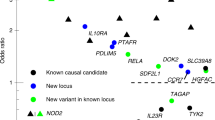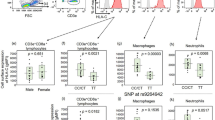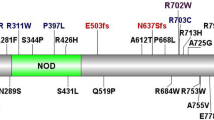Abstract
Hepatocyte nuclear 4 alpha (HNF4α), involved in glucose and lipid metabolism, has been linked to intestinal inflammation and abnormal mucosal permeability. Moreover, in a genome-wide association study, the HNF4A locus has been associated with ulcerative colitis. The objective of our study was to evaluate the association between HNF4α genetic variants and Crohn’s disease (CD) in two distinct Canadian pediatric cohorts. The sequencing of the HNF4A gene in 40 French Canadian patients led to the identification of 27 single nucleotide polymorphism (SNP)s with a minor allele frequency >5%. To assess the impact of these SNPs on disease susceptibility, we first conducted a case–control discovery study on 358 subjects with CD and 542 controls. We then carried out a replication study in a separate cohort of 416 cases and 1208 controls. In the discovery cohort, the genotyping of the identified SNPs revealed that six were significantly associated with CD. Among them, rs1884613 was replicated in the second CD cohort (odds ratio (OR): 1.33; P<0.012) and this association remained significant when both cohorts were combined and after correction for multiple testing (OR: 1.39; P<0.004). An 8-marker P2 promoter haplotype containing rs1884613 was also found associated with CD (P<2.09 × 10−4 for combined cohorts). This is the first report showing that the HNF4A locus may be a common genetic determinant of childhood-onset CD. These findings highlight the importance of the intestinal epithelium and oxidative protection in the pathogenesis of CD.
This is a preview of subscription content, access via your institution
Access options
Subscribe to this journal
Receive 6 digital issues and online access to articles
$119.00 per year
only $19.83 per issue
Buy this article
- Purchase on Springer Link
- Instant access to full article PDF
Prices may be subject to local taxes which are calculated during checkout





Similar content being viewed by others
References
Bernstein CN, Wajda A, Svenson LW, MacKenzie A, Koehoorn M, Jackson M et al. The epidemiology of inflammatory bowel disease in Canada: a population-based study. Am J Gastroenterol 2006; 101: 1559–1568.
Kappelman MD, Rifas-Shiman SL, Kleinman K, Ollendorf D, Bousvaros A, Grand RJ et al. The prevalence and geographic distribution of Crohn’s disease and ulcerative colitis in the United States. Clin Gastroenterol Hepatol 2007; 5: 1424–1429.
Rioux JD, Xavier RJ, Taylor KD, Silverberg MS, Goyette P, Huett A et al. Genome-wide association study identifies new susceptibility loci for Crohn disease and implicates autophagy in disease pathogenesis. Nat Genet 2007; 39: 596–604.
Parkes M, Barrett JC, Prescott NJ, Tremelling M, Anderson CA, Fisher SA et al. Sequence variants in the autophagy gene IRGM and multiple other replicating loci contribute to Crohn's disease susceptibility. Nat Genet 2007; 39: 830–832.
Prescott NJ, Fisher SA, Franke A, Hampe J, Onnie CM, Soars D et al. A nonsynonymous SNP in ATG16L1 predisposes to ileal Crohn’s disease and is independent of CARD15 and IBD5. Gastroenterology 2007; 132: 1665–1671.
Amre DK, Mack D, Israel D, Morgan K, Lambrette P, Law L et al. Association between genetic variants in the IL-23R gene and early-onset Crohn’s disease: results from a case-control and family-based study among Canadian children. Am J Gastroenterol 2008; 103: 615–620.
Franke A, McGovern DP, Barrett JC, Wang K, Radford-Smith GL, Ahmad T et al. Genome-wide meta-analysis increases to 71 the number of confirmed Crohn’s disease susceptibility loci. Nat Genet 2010; 42: 1118–1125.
Rivas MA, Beaudoin M, Gardet A, Stevens C, Sharma Y, Zhang CK et al. Deep resequencing of GWAS loci identifies independent rare variants associated with inflammatory bowel disease. Nat Genet 2011; 43: 1066–1073.
Sladek FM, Zhong WM, Lai E, Darnell JE . Liver-enriched transcription factor HNF-4 is a novel member of the steroid hormone receptor superfamily. Genes Dev 1990; 4: 2353–2365.
Taraviras S, Monaghan AP, Schutz G, Kelsey G . Characterization of the mouse HNF-4 gene and its expression during mouse embryogenesis. Mech Dev 1994; 48: 67–79.
Miquerol L, Lopez S, Cartier N, Tulliez M, Raymondjean M, Kahn A . Expression of the L-type pyruvate kinase gene and the hepatocyte nuclear factor 4 transcription factor in exocrine and endocrine pancreas. J Biol Chem 1994; 269: 8944–8951.
Stoffel M, Duncan SA . The maturity-onset diabetes of the young (MODY1) transcription factor HNF4alpha regulates expression of genes required for glucose transport and metabolism. Proc Natl Acad Sci USA 1997; 94: 13209–13214.
Chien CC, Yen BL, Lee FK, Lai TH, Chen YC, Chan SH et al. In vitro differentiation of human placenta-derived multipotent cells into hepatocyte-like cells. Stem Cells 2006; 24: 1759–1768.
Fiegel HC, Lioznov MV, Cortes-Dericks L, Lange C, Kluth D, Fehse B et al. Liver-specific gene expression in cultured human hematopoietic stem cells. Stem Cells 2003; 21: 98–104.
Lian G, Wang C, Teng C, Zhang C, Du L, Zhong Q et al. Failure of hepatocyte marker-expressing hematopoietic progenitor cells to efficiently convert into hepatocytes in vitro. Exp Hematol 2006; 34: 348–358.
Parviz F, Matullo C, Garrison WD, Savatski L, Adamson JW, Ning G et al. Hepatocyte nuclear factor 4alpha controls the development of a hepatic epithelium and liver morphogenesis. Nat Genet 2003; 34: 292–296.
Sladek FM . Orphan receptor HNF-4 and liver-specific gene expression. Receptor 1993; 3: 223–232.
Boj SF, Parrizas M, Maestro MA, Ferrer J . A transcription factor regulatory circuit in differentiated pancreatic cells. Proc Natl Acad Sci USA 2001; 98: 14481–14486.
Thomas H, Jaschkowitz K, Bulman M, Frayling TM, Mitchell SM, Roosen S et al. A distant upstream promoter of the HNF-4alpha gene connects the transcription factors involved in maturity-onset diabetes of the young. Hum Mol Genet 2001; 10: 2089–2097.
Briancon N, Weiss MC . In vivo role of the HNF4alpha AF-1 activation domain revealed by exon swapping. EMBO J 2006; 25: 1253–1262.
Rhee J, Inoue Y, Yoon JC, Puigserver P, Fan M, Gonzalez FJ et al. Regulation of hepatic fasting response by PPARgamma coactivator-1alpha (PGC-1): requirement for hepatocyte nuclear factor 4alpha in gluconeogenesis. Proc Natl Acad Sci USA 2003; 100: 4012–4017.
Wang H, Maechler P, Antinozzi PA, Hagenfeldt KA, Wollheim CB . Hepatocyte nuclear factor 4alpha regulates the expression of pancreatic beta-cell genes implicated in glucose metabolism and nutrient-induced insulin secretion. J Biol Chem 2000; 275: 35953–35959.
Bartoov-Shifman R, Hertz R, Wang H, Wollheim CB, Bar-Tana J, Walker MD . Activation of the insulin gene promoter through a direct effect of hepatocyte nuclear factor 4 alpha. J Biol Chem 2002; 277: 25914–25919.
Tegude H, Schnabel A, Zanger UM, Klein K, Eichelbaum M, Burk O . Molecular mechanism of basal CYP3A4 regulation by hepatocyte nuclear factor 4alpha: evidence for direct regulation in the intestine. Drug Metab Dispos 2007; 35: 946–954.
Fajans SS, Bell GI, Polonsky KS . Molecular mechanisms and clinical pathophysiology of maturity-onset diabetes of the young. N Engl J Med 2001; 345: 971–980.
Bagwell AM, Bento JL, Mychaleckyj JC, Freedman BI, Langefeld CD, Bowden DW . Genetic analysis of HNF4A polymorphisms in Caucasian-American type 2 diabetes. Diabetes 2005; 54: 1185–1190.
Hansen SK, Rose CS, Glumer C, Drivsholm T, Borch-Johnsen K, Jorgensen T et al. Variation near the hepatocyte nuclear factor (HNF)-4alpha gene associates with type 2 diabetes in the Danish population. Diabetologia 2005; 48: 452–458.
Vaxillaire M, Dina C, Lobbens S, Dechaume A, Vasseur-Delannoy V, Helbecque N et al. Effect of common polymorphisms in the HNF4alpha promoter on susceptibility to type 2 diabetes in the French Caucasian population. Diabetologia 2005; 48: 440–444.
Garrison WD, Battle MA, Yang C, Kaestner KH, Sladek FM, Duncan SA . Hepatocyte nuclear factor 4alpha is essential for embryonic development of the mouse colon. Gastroenterology 2006; 130: 1207–1220.
Frochot V, Alqub M, Cattin AL, Carriere V, Houllier A, Baraille F et al. The transcription factor HNF-4alpha: a key factor of the intestinal uptake of fatty acids in mouse. Am J Physiol Gastrointest Liver Physiol 2012; 302: G1253–G1263.
Lussier CR, Babeu JP, Auclair BA, Perreault N, Boudreau F . Hepatocyte nuclear factor-4alpha promotes differentiation of intestinal epithelial cells in a coculture system. Am J Physiol Gastrointest Liver Physiol 2008; 294: G418–G428.
Babeu JP, Darsigny M, Lussier CR, Boudreau F . Hepatocyte nuclear factor 4alpha contributes to an intestinal epithelial phenotype in vitro and plays a partial role in mouse intestinal epithelium differentiation. Am J Physiol Gastrointest Liver Physiol 2009; 297: G124–G134.
Darsigny M, Babeu JP, Dupuis AA, Furth EE, Seidman EG, Levy E et al. Loss of hepatocyte-nuclear-factor-4alpha affects colonic ion transport and causes chronic inflammation resembling inflammatory bowel disease in mice. PLoS One 2009; 4: e7609.
Marcil V, Seidman E, Sinnett D, Boudreau F, Gendron FP, Beaulieu JF et al. Modification in oxidative stress, inflammation and lipoprotein assembly in response to hepatocyte nuclear factor 4 alpha knockdown in intestinal epithelial cells. J Biol Chem 2010; 285: 40448–40460.
Barrett JC, Lee JC, Lees CW, Prescott NJ, Anderson CA, Phillips A et al. Genome-wide association study of ulcerative colitis identifies three new susceptibility loci, including the HNF4A region. Nat Genet 2009; 41: 1330–1334.
Bonnycastle LL, Willer CJ, Conneely KN, Jackson AU, Burrill CP, Watanabe RM et al. Common variants in maturity-onset diabetes of the young genes contribute to risk of type 2 diabetes in Finns. Diabetes 2006; 55: 2534–2540.
Weissglas-Volkov D, Huertas-Vazquez A, Suviolahti E, Lee J, Plaisier C, Canizales-Quinteros S et al. Common hepatic nuclear factor-4alpha variants are associated with high serum lipid levels and the metabolic syndrome. Diabetes 2006; 55: 1970–1977.
Silverberg MS, Satsangi J, Ahmad T, Arnott ID, Bernstein CN, Brant SR et al. Toward an integrated clinical, molecular and serological classification of inflammatory bowel disease: report of a Working Party of the 2005 Montreal World Congress of Gastroenterology. Can J Gastroenterol 2005; 19 (Suppl A): 5–36.
Ahn SH, Shah YM, Inoue J, Morimura K, Kim I, Yim S et al. Hepatocyte nuclear factor 4alpha in the intestinal epithelial cells protects against inflammatory bowel disease. Inflamm Bowel Dis 2008; 14: 908–920.
De BK, Vanden Berghe W, Haegeman G . Cross-talk between nuclear receptors and nuclear factor kappaB. Oncogene 2006; 25: 6868–6886.
Nikolaidou-Neokosmidou V, Zannis VI, Kardassis D . Inhibition of hepatocyte nuclear factor 4 transcriptional activity by the nuclear factor kappaB pathway. Biochem J 2006; 398: 439–450.
Amre DK, Mack DR, Morgan K, Israel D, Deslandres C, Seidman EG et al. Association between genome-wide association studies reported SNPs and pediatric-onset Crohn’s disease in Canadian children. Hum Genet 2010; 128: 131–135.
Bianco AM, Zanin V, Girardelli M, Magnolato A, Martellossi S, Tommasini A et al. A common genetic background could explain early-onset Crohn’s disease. Med Hypotheses 2012; 78: 520–522.
Sladek FM, Seidel SD . Hepatocyte nuclear factor 4á. In: Burris TP, McCabe E (eds). Nuclear Receptors and Genetic Diseases. Academic Press London, UK, 2001, pp 309–361.
Ellard S, Colclough K . Mutations in the genes encoding the transcription factors hepatocyte nuclear factor 1 alpha (HNF1A) and 4 alpha (HNF4A) in maturity-onset diabetes of the young. Hum Mutat 2006; 27: 854–869.
Barroso I, Luan J, Wheeler E, Whittaker P, Wasson J, Zeggini E et al. Population-specific risk of type 2 diabetes conferred by HNF4A P2 promoter variants: a lesson for replication studies. Diabetes 2008; 57: 3161–3165.
Lehman DM, Richardson DK, Jenkinson CP, Hunt KJ, Dyer TD, Leach RJ et al. P2 promoter variants of the hepatocyte nuclear factor 4alpha gene are associated with type 2 diabetes in Mexican Americans. Diabetes 2007; 56: 513–517.
Johansson S, Raeder H, Eide SA, Midthjell K, Hveem K, Sovik O et al. Studies in 3523 Norwegians and meta-analysis in 11,571 subjects indicate that variants in the hepatocyte nuclear factor 4 alpha (HNF4A) P2 region are associated with type 2 diabetes in Scandinavians. Diabetes 2007; 56: 3112–3117.
Saif-Ali R, Harun R, Al-Jassabi S, Wan Ngah WZ . Hepatocyte nuclear factor 4 alpha P2 promoter variants associate with insulin resistance. Acta Biochim Pol 2011; 58: 179–186.
Winckler W, Graham RR, de Bakker PI, Sun M, Almgren P, Tuomi T et al. Association testing of variants in the hepatocyte nuclear factor 4alpha gene with risk of type 2 diabetes in 7883 people. Diabetes 2005; 54: 886–892.
Seldin MF, Amos CI . Shared susceptibility variations in autoimmune diseases: a brief perspective on common issues. Genes Immun 2009; 10: 1–4.
Huang W, Wang P, Liu Z, Zhang L . Identifying disease associations via genome-wide association studies. BMC Bioinformatics 2009; 10 (Suppl 1): S68.
Eleftherohorinou H, Wright V, Hoggart C, Hartikainen AL, Jarvelin MR, Balding D et al. Pathway analysis of GWAS provides new insights into genetic susceptibility to 3 inflammatory diseases. PLoS One 2009; 4: e8068.
Liu H, Hew HC, Lu ZG, Yamaguchi T, Miki Y, Yoshida K . DNA damage signalling recruits RREB-1 to the p53 tumour suppressor promoter. Biochem J 2009; 422: 543–551.
Flajollet S, Poras I, Carosella ED, Moreau P . RREB-1 is a transcriptional repressor of HLA-G. J Immunol 2009; 183: 6948–6959.
Battle MA, Konopka G, Parviz F, Gaggl AL, Yang C, Sladek FM et al. Hepatocyte nuclear factor 4alpha orchestrates expression of cell adhesion proteins during the epithelial transformation of the developing liver. Proc Natl Acad Sci USA 2006; 103: 8419–8424.
Satohisa S, Chiba H, Osanai M, Ohno S, Kojima T, Saito T et al. Behavior of tight-junction, adherens-junction and cell polarity proteins during HNF-4alpha-induced epithelial polarization. Exp Cell Res 2005; 310: 66–78.
Cattin AL, Le BJ, Barreau F, Saint-Just S, Houllier A, Gonzalez FJ et al. Hepatocyte nuclear factor 4alpha, a key factor for homeostasis, cell architecture, and barrier function of the adult intestinal epithelium. Mol Cell Biol 2009; 29: 6294–6308.
Genser D, Kang MH, Vogelsang H, Elmadfa I . Status of lipidsoluble antioxidants and TRAP in patients with Crohn's disease and healthy controls. Eur J Clin Nutr 1999; 53: 675–679.
Lennard-Jones JE . Classification of inflammatory bowel disease. Scand J Gastroenterol Suppl 1989; 170: 2–6.
Sands BE . From symptom to diagnosis: clinical distinctions among various forms of intestinal inflammation. Gastroenterology 2004; 126: 1518–1532.
Tang H, Quertermous T, Rodriguez B, Kardia SL, Zhu X, Brown A et al. Genetic structure, self-identified race/ethnicity, and confounding in case-control association studies. Am J Hum Genet 2005; 76: 268–275.
Paradis G, Lambert M, O’Loughlin J, Lavallee C, Aubin J, Berthiaume P et al. The Quebec Child and Adolescent Health and Social Survey: design and methods of a cardiovascular risk factor survey for youth. Can J Cardiol 2003; 19: 523–531.
Andrulionyte L, Laukkanen O, Chiasson JL, Laakso M . Single nucleotide polymorphisms of the HNF4alpha gene are associated with the conversion to type 2 diabetes mellitus: the STOP-NIDDM trial. J Mol Med 2006; 84: 701–708.
Muller YL, Infante AM, Hanson RL, Love-Gregory L, Knowler W, Bogardus C et al. Variants in hepatocyte nuclear factor 4alpha are modestly associated with type 2 diabetes in Pima Indians. Diabetes 2005; 54: 3035–3039.
Corpet F . Multiple sequence alignment with hierarchical clustering. Nucleic Acids Res 1988; 16: 10881–10890.
Koo SH, Ong TC, Chong KT, Lee CG, Chew FT, Lee EJ . Multiplexed genotyping of ABC transporter polymorphisms with the Bioplex suspension array. Biol Proced Online 2007; 9: 27–42.
Bourgey M, Lariviere M, Richer C, Sinnett DALG . Automated genotype calling of luminex assays. PLoS One 2011; 6: e19368.
Courtois F, Suc I, Garofalo C, Ledoux M, Seidman E, Levy E . Iron-ascorbate alters the efficiency of Caco-2 cells to assemble and secrete lipoproteins. Am J Physiol Gastrointest Liver Physiol 2000; 279: G12–G19.
Levy E, Rizwan Y, Thibault L, Lepage G, Brunet S, Bouthillier L et al. Altered lipid profile, lipoprotein composition, and oxidant and antioxidant status in pediatric Crohn disease. Am J Clin Nutr 2000; 71: 807–815.
Barrett JC, Fry B, Maller J, Daly MJ . Haploview: analysis and visualization of LD and haplotype maps. Bioinformatics 2005; 21: 263–265.
Acknowledgements
This study was supported by the Canadian Institutes of Health Research Team Grant (CTP-82942; ES, FB, FPG, JFB, DM and EL), the JA DeSève Research Chair in Nutrition (EL), the Canada Research Chair in Immune Mediated Gastrointestinal Disorders (ES), the Canadian Institutes of Health Research Fellowship Award and The Richard and Edith Strauss Postdoctoral Fellowships Award in Medicine, McGill University (VM). A preliminary version of this study, presented by VM, was awarded with a Presidential Poster Award at the American College of Gastroenterology 2010 Annual Scientific Meeting. We thank Mrs Schohraya Spahis for her technical assistance.
Author information
Authors and Affiliations
Corresponding author
Ethics declarations
Competing interests
The authors declare no conflict of interest.
Rights and permissions
About this article
Cite this article
Marcil, V., Sinnett, D., Seidman, E. et al. Association between genetic variants in the HNF4A gene and childhood-onset Crohn’s disease. Genes Immun 13, 556–565 (2012). https://doi.org/10.1038/gene.2012.37
Received:
Accepted:
Published:
Issue Date:
DOI: https://doi.org/10.1038/gene.2012.37
Keywords
This article is cited by
-
Revealing potential drug-disease-gene association patterns for precision medicine
Scientometrics (2021)
-
Global hypermethylation of intestinal epithelial cells is a hallmark feature of neonatal surgical necrotizing enterocolitis
Clinical Epigenetics (2020)
-
Nuclear receptor HNF4α performs a tumor suppressor function in prostate cancer via its induction of p21-driven cellular senescence
Oncogene (2020)



